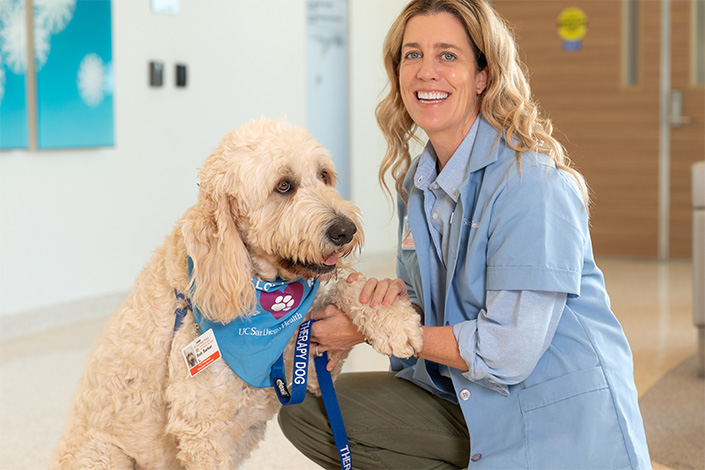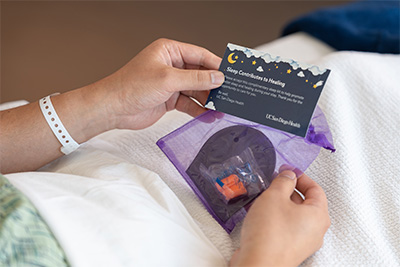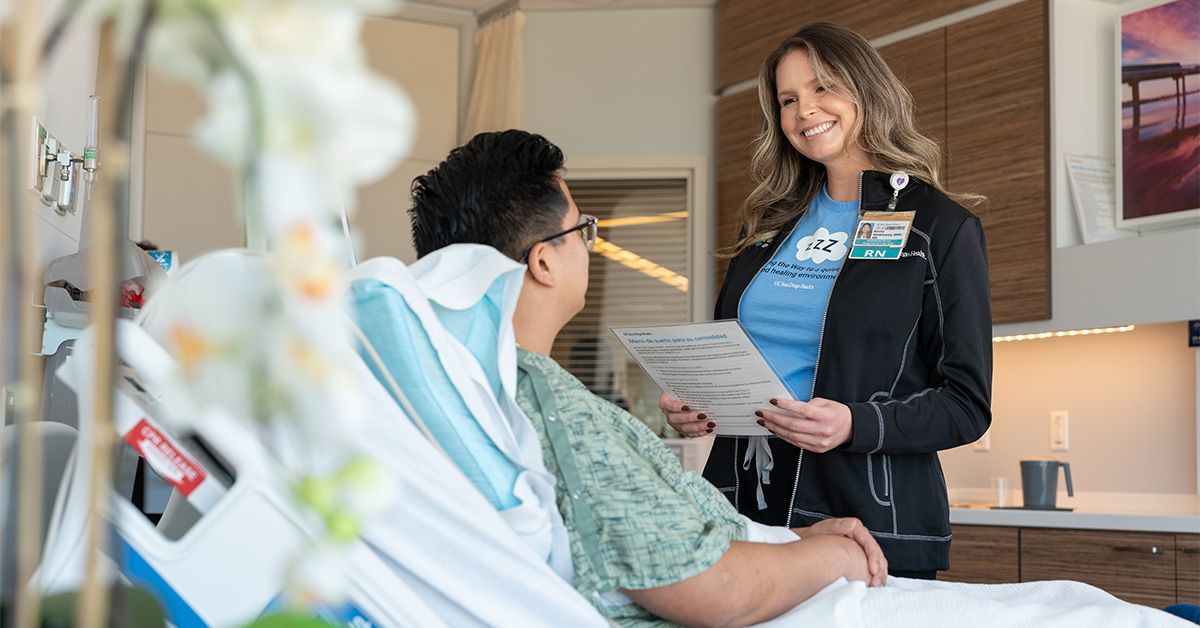Leading the Way With Care
From ‘sleep menus’ to pet therapy, UC San Diego Health is dedicated to transforming patient care with human-centered experiences — at every touch point.
Published Date
Article Content
This story is from the 2025 issue of Discoveries, a UC San Diego Health Sciences magazine.
Elena Javier was born with a rare congenital heart defect that can ultimately lead to heart failure. Called an Ebstein anomaly, she lived with symptoms of exhaustion and labored breathing for five decades. Her health progressively declined until, at age 53, she received advanced care at UC San Diego Health by way of a new heart and an empowering care team.
Javier, originally from San Francisco and now residing in Encinitas, had seen countless doctors and cardiologists over the years without a concrete solution. She was referred to UC San Diego Health in 2020. That’s when a heart transplant was recommended by Laith Alshawabkeh, MD, associate professor of cardiovascular medicine at UC San Diego School of Medicine and director of the Adult Congenital Heart program at UC San Diego Health. Her heart was functioning at just 20%.

“To learn that I needed a heart transplant was shocking — I wondered if I could have prevented it by having heart surgery earlier, yet that hadn’t been recommended by any of the doctors I had seen over all those years,” said Javier, who is now 56. “But my journey with the UC San Diego Health transplant team was nothing short of amazing. From the very beginning of the transplant process, they were an incredible team, explaining everything to me in ways I could understand, and holding my hand every step of the way.”
Elevating patient experiences during the most vulnerable moments of their lives is a guiding principle for the care teams at UC San Diego Health. The human touch, compassion and meaningful interactions can greatly impact patients and their loved ones in our hospitals, according to Lesley Wilson, chief experience officer for UC San Diego Health. Patient interactions and care are driven by a framework called “Leading the Way” at UC San Diego Health, which empowers the entire team to create an environment where everyone feels cared for and belongs.
“We really believe in the importance of intentionally designed experiences combined with the warmth of human-centered hospitality throughout our patients’ care journey,” Wilson said. “For us, it’s about being there to help guide them through their medical situation in the most compassionate way. We know we can’t always cure them, but we can always support their healing.”
That dedication to empathetic patient care is what kept Javier optimistic throughout her heart transplant process. It also compelled her, after recovery, to volunteer on two UC San Diego Health Patient and Family Advisory Councils, which provide guidance to further enhance patient experiences and evaluate improvement strategies for UC San Diego Health.
“My life was going to end, and that whole team was there for me,” Javier remembers. “They made me feel taken care of, educated and just really special. I decided to give back through this volunteer work I’m doing because I want that experience for other patients. I also feel this is a way I can honor my heart donor.”
A positive patient experience like Javier’s can help speed up recovery and improve health outcomes, according to the National Institutes of Health (NIH) and the Agency for Healthcare Research and Quality (AHRQ), the lead federal agency charged with improving the safety and quality of health care in the U.S. For example, AHRQ studies of patients hospitalized for heart attacks show that those with positive reports about their experiences with care had better health outcomes a year after discharge.
“We really believe in the importance of intentionally designed experiences combined with the warmth of human-centered hospitality throughout our patients’ care journey.”
“Our team instills confidence and trust, providing patients the assurance that they are in the right hands. We communicate transparently with patients and make it easy for them to ask questions. Leading the way in patient care and experience is what we are always striving for as an organization,” Wilson said.
Compassionate Care, Transformational Outcomes
A welcoming hospital atmosphere is essential to improve patient well-being and encourage healing, according to the NIH. Both the physical and social environments play a crucial role in creating a positive patient experience.
Laura Vento, a nurse manager at UC San Diego Health, recalls that both of those factors were lacking throughout her father’s liver transplant process in 2010 on the East Coast.
“We did not have a great experience. He had a lot of complications, and my mom, who was his primary caregiver, was left with so many unanswered questions. Ever since then, I thought, ‘There has to be a better way.’”
Fast forward to the nursing team Vento now leads on the fourth floor of Jacobs Medical Center. Compassionate care is at the core of the “Leading the Way” philosophy at UC San Diego Health. Her team routinely engages with patients to discover what is most important to them and then delivers.
“It might be a clinical milestone they want to meet, a Padres game they hope to watch, having their loved one stay overnight with them or getting their nails painted,” Vento said. “Our team goes above and beyond to find creative ways to make as many of those important moments happen as possible. It’s inspiring.”
She fondly recalls a patient who had been in the intensive care unit for more than three weeks and yearned for some fresh air outside.
“It required the extra effort of the physical therapy team and the lift team to get him to our outdoor terrace, but it just meant everything to him — to feel the air and sun on his face. He cried.” Moments like this create meaning and emotion not just for the patients but for the team members who make them happen.


Provided sleep kits include aromatherapy, earplugs and a “sleep menu” that helps the care team determine specific ways they can make a patient’s time in the hospital quiet and restful.
The patient experience is a measure of quality and safety of care that encompasses interactions between patients and the health system. It includes every touch point — care experiences, clinical interactions, the health care environment and essential processes — along with the systems and structures in place to support team members who are caring for patients.
Key areas of focus include creating a comfortable patient environment (which can help reduce patient anxiety), educating and engaging patients to keep them informed and involved in their treatment plan, and making the transition back home as smooth and easy as possible.
“When patients are feeling heard and valued, and they are engaged in their care plan, it is a key to their recovery,” Vento said, remembering a father who was in the hospital during his son’s graduation and the nursing team who creatively found a way to live stream the ceremony into his room.
“We promote early mobilization to have better patient outcomes and reduced length of stay, and to do that, it takes the encouragement of our nurses who are both a patient’s expert guide and cheerleader to help take their mind off the discomfort and even make it fun.”
A Vision for Unifying, Connecting, Seeing and Discovering
The Office of Experience Transformation at UC San Diego Health was launched 10 years ago to empower every team member to design and champion more meaningful patient experiences and care. The academic medical center’s “Leading the Way” culture framework is an acronym for UCSD, which centers on:
- Unifying: Partnering together as a unified team.
- Connecting: Bonding with each other through relationships and interactions.
- Seeing: Looking for the good and helping everyone feel seen and heard.
- Discovering: Finding new ways to design and improve experiences.
“We want patients to feel that we are working together as a unified team — as partners in their care,” Wilson said. “Are we connecting all the important dots? Are we building and nurturing relationships? Are we seeing them for who they are as unique individuals, noticing important details and personalizing their healing journey? And are we taking every opportunity to discover new ways to make their experience the best it can be? That is our intention and goal every day.”
Edmundo Galvan, a valued member of UC San Diego Health’s facilities and engineering team for the past 18 years, is a pro at spotting issues that require creative fixes. He routinely searches for and remedies door latches and hinges that are making noise and not closing correctly. One quiet night in an empty hallway, he noticed the wheels on a specific type of cart all made a squeaking and clanking noise that he feared was disturbing patients’ sleep.
“Our team instills confidence and trust, providing patients the assurance that they are in the right hands. We communicate transparently with patients and make it easy for them to ask questions.”
“I like the challenge to figure something out. I discovered the castings on the wheels were old and no longer working correctly,” he said, reflecting on all the research he conducted and the four different sets of casters he tried before finding the perfect fit and replacing the squeaky wheels on all the carts.
“It makes me feel good to know that I am helping patients in even the smallest ways because I know the goal is for them to get well and get back home,” he said with a smile. “I’m always looking for anything that is making noise or not working quite right.” Galvan’s passion and determination is the embodiment of the organization’s belief that it is often the little details that make the biggest difference.
When Vento and her team do morning rounds at Jacobs Medical Center, she routinely notices the thoughtful touches that have been incorporated throughout the hospital to promote a calming environment. Many of the patient rooms include beautiful photography of outdoor scenes. Patients are greeted by healing music and relaxing images on their TVs. Provided sleep kits include aromatherapy, earplugs and a “sleep menu” that helps the care team determine specific ways they can make a patient’s time in the hospital as quiet and restful as it can be.
“I’m very proud to work in a hospital where so much thought goes into creating a healing environment for our patients,” Vento said. “Our patient rooms include soothing, natural elements, comfortable spaces for family members to spend time with their loved ones, big windows and even curved walls to make the space less stark. It all makes a huge difference in a patient’s outlook.”
In addition, care teams round daily to welcome and check in with patients, ensure families feel informed and involved in the process and orchestrate special celebrations for milestones and birthdays. More than 400 patients spend their birthdays at UC San Diego Health each year, and those whose diet allows receive a celebratory birthday cake and card.
“What patients take away from their time with us is how we made them feel in those important moments,” Wilson said. “We want to make sure that everything we do contributes to creating a lasting and meaningful memory, fueled by these human connections with our team.”
For those whose primary language is not English, interpreter services are provided, enabling patients to feel confident communicating in their own language. In addition, the care team notes spiritual preferences, and the hospital’s chaplain team of volunteers from multiple denominations provides patients with spiritual visits. Pet therapy is also offered through volunteers who bring trained dogs into the hospital on occasion to visit patients who yearn for a canine cuddle.
“Creating a meaningful and memorable experience for patients starts first by creating a meaningful and memorable experience for team members,” Wilson said. “Through ‘Leading the Way,’ we prioritize the importance of our culture and team member experience — providing well-being programs, educational sessions, celebration and gratitude gatherings and unique joy events.”
“We believe it’s important for our team members to reenergize and recharge because when you feel taken care of, you can bring your very best self to caring for our patients.”
Throughout Javier’s heart transplant process at UC San Diego Health, the compassion and empowerment from each member of her care team enhanced her journey.
“Yes, I had to have a heart transplant, but you know, it was actually an incredible experience,” Javier recalls. “I had complete trust in the entire team and knew they were there for me. I am so grateful to each one of them for supporting me throughout my journey at UC San Diego Health.”
Share This:
You May Also Like
UC San Diego is Strengthening U.S. Semiconductor Innovation and Workforce Development
Technology & EngineeringStay in the Know
Keep up with all the latest from UC San Diego. Subscribe to the newsletter today.







